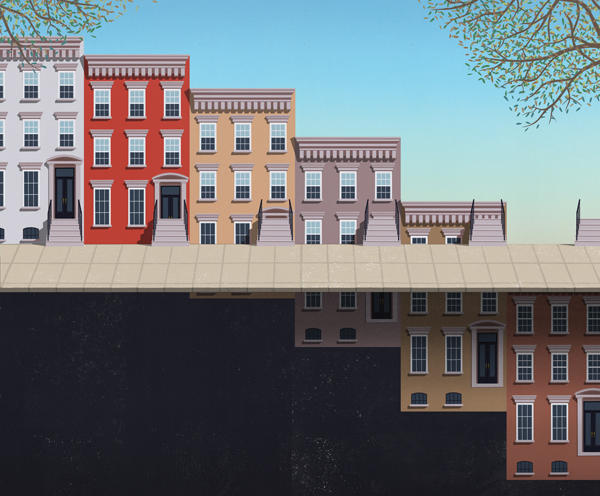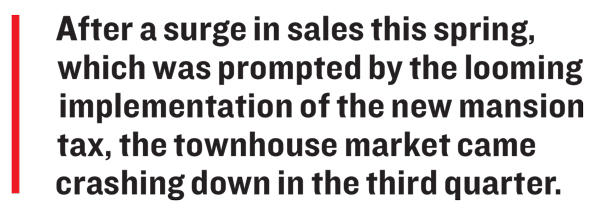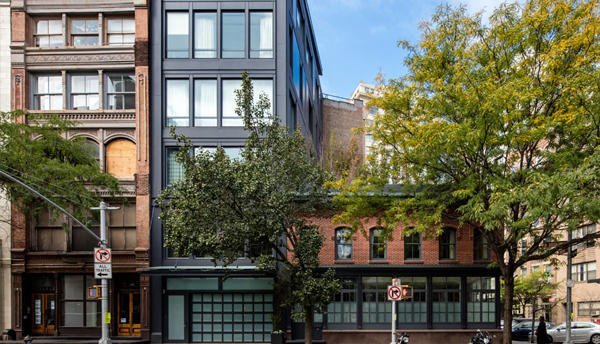Trending
Trouble in the townhouse market?
While the sector recently saw a blockbuster $77 million deal, the overall mega-mansion market has taken a downward turn

As a percentage of the city’s housing stock, townhouses aren’t just small, they’re minuscule. But they’ve attracted outsized attention in recent months.
Most notably, this summer, a 48-foot-wide limestone mansion on East 67th Street sold to hedge-fund mogul John Griffin for $77 million — the highest price ever paid for a residential townhouse in New York City.
While that blockbuster deal set a new benchmark, sources say it’s not reflective of what’s going on in the city’s exclusive townhouse market right now. Or as Douglas Elliman’s Noble Black said, “I don’t think that one big deal means there’s a stampede for townhouses.”
Like the rest of the luxury market, the townhouse market is struggling.
After a surge in sales this spring, which was prompted by the looming implementation of the new mansion tax, the townhouse market came crashing down in the third quarter.
The third quarter logged 37 single-family townhouse sales in Manhattan and northwest Brooklyn, down a massive 45 percent year over year from 67, according to data from the residential brokerage Core.
“The best word to describe the market right now is ‘uncertainty,’” according to Core’s Garrett Derderian, who prepared the data. “Foreign capital has pulled back and inventory has crept up, and buyers are taking their time.”
To be sure, Manhattan saw more townhouse sales between January and September of this year than it did in the same period last year. But it’s clear that there was an artificial bump and that it’s slow going now.
Of course, a small drop can make a big difference in such a tiny sliver of the market. While Manhattan saw 10,000-plus co-op and condo sales in 2018, just 232 of them were townhouse deals, according to Elliman.
 Nonetheless, prices have nosedived, and townhouses are taking longer to sell than they did even just a year ago. “The third quarter was really just a mess,” said Jed Garfield, managing partner of Leslie J. Garfield & Company, the townhouse firm his father founded.
Nonetheless, prices have nosedived, and townhouses are taking longer to sell than they did even just a year ago. “The third quarter was really just a mess,” said Jed Garfield, managing partner of Leslie J. Garfield & Company, the townhouse firm his father founded.
Compass’ Vickey Barron, meanwhile, said: “It’s a slow-boat market, not a speedboat market.”
Discount city
While prices in the townhouse market are far higher than they are in the rest of the market, that hasn’t meant fewer discounts.
The average townhouse sale price for Manhattan and prime Brooklyn was $3.46 million in the third quarter — roughly 51 percent down from the $7.02 million logged one year earlier, according to Core.
And those discounts are not hard to find.
In September, Italian fashion designer Luca Orlandi sold his Upper East Side townhouse for $27 million — more than two years after listing it for $40 million. And a few months earlier, in June, a historic townhouse facing Central Park sold for $16.25 million after hitting the market last year for $29 million.
“The market’s been tough, so that’s why the seller agreed to the price,” Sotheby’s International Realty’s Michael Sieger, one of the listing’s brokers, told The Real Deal at the time.
Meanwhile, in late June, 2 North Moore Street in Tribeca sold for $27 million, down from the initial 2014 asking price of $48 million.
In that case, it took private equity executive Mark Zittman and his wife five years to unload the 11,300-square-foot house, which has a three-car garage, an art studio and a 50-foot heated pool.
One issue for the townhouse market — in additional to the general economic uncertainty — is the increased competition from the über-luxury condo world, where buildings like 432 Park Avenue, 220 Central Park South and 520 Park Avenue are selling sprawling multi-floor penthouses that re-create the feeling of a single-family home.
Some, however, say signed townhouse contracts, which are not captured in sales data, are increasing and that the sector is improving.
“The death of townhouses has been greatly exaggerated,” said Elliman’s George Vanderploeg, whose team specializes in townhouses. “There’s good traffic and interest.”
This fall, Vanderploeg received an offer on 124 East 64th Street, which was listed at $12 million — a big chop from the $16.9 it came on for in 2016.
“Those early prices were aspirational,” said Vanderploeg, who added that the property had a renter in place for the last year, making it difficult to show. “It was not what we were recommending.”
Garfield said he’s not entirely surprised that the market is down. Those in the townhouse buyer demographic — who include investment bankers and hedge-funders — are “not making as much money as they used to,” he said.
Deutsche Bank announced this summer that it would be axing 18,000 employees by 2022, Garfield noted. “If there’s nobody behind you on a deal, if there’s nobody else looking to bid, then you’re probably not going to bid yourself,” he said.
Whispers and taxes
It’s hard, however, to gauge what’s truly happening in the townhouse market because many of the deals are done as “whisper listings.”
These homes draw a more private class of buyers — whether they’re celebrities, dignitaries or billionaire business executives.

Going off-market means no listings photos for strangers to gawk at online and no open houses. Everything is done on an exclusive, by-appointment-only basis.
And these off-market deals are the reality of the broader luxury market as well.
In 2018, nearly half of the residential properties in New York that sold for more than $20 million were whisper listings, according to an analysis by Compass.
Vanderploeg said that two of the six townhouses he’s sold so far in 2019 were off-market. “When you have a correction, and sellers aren’t getting their prices, they take them off the market in frustration,” he said. “And then people like me contact them, and we make deals.”
The Griffin deal was another one done out of the public eye.
Broker Adam Modlin shopped that property — the longtime home of Bob Guccione, publisher of Penthouse — which financier Philip Falcone and his wife, Lisa, bought in 2008 for $49 million. (Guccione, who built a pornography empire, lost the townhouse to creditors as his business started failing.)
Developer Joseph Moinian, meanwhile, bought the four-story townhouse at 175 East 73rd Street owned by shoe magnate Steve Madden for about $9 million in another off-market deal.
“Joe called me up and said, ‘Carrie, can you get the neighbor?’” the Corcoran Group’s Carrie Chiang recalled, noting that Moinian first bought the garage next door and then purchased the Madden townhouse.
Moinian is now bankrolling the construction of a synagogue and social hall geared toward the Persian Jewish community at the site, according to news reports.
Tax buoy or bust?
While today’s townhouse market has hit a rough patch, the sales bump, which came as buyers were rushing to lock in deals before the new state mansion tax kicked in on July 1, has buoyed the market for much of the year.
Manhattan saw 71 single-family townhouse sales between January and September 2019 — up from 61 during the same stretch of last year.
But that buying frenzy is now over. And it was not unique to the townhouse market. The city’s luxury market hit record levels in June ahead of the tax’s debut.

2 North Moore Street sold for $27 million, down from $48 million in 2014
The new mansion tax ranges from 0.25 to 2.9 percent and applies to residential properties at $2 million-plus. Those fees come on top of the existing 1 percent tax on residential transactions of $1 million or more. In addition, the state hiked transfer taxes 0.25 percentage points on residential properties of more than $3 million.
Brokers said the stampede to lock in lower taxes increased deal volume by about 15 to 20 percent.
Elliman’s Vanderploeg said his second quarter was busier than usual but that deals have slowed a bit since the tax changes took effect. Yet he noted that buyers in this price range are not calculating their purchases with every penny of savings in mind. “They won’t be put off by another couple percent,” he said.
These new tax burdens aren’t the only factors (outside of the sale price) that impact that townhouse market.
Condo owners pay monthly common charges — which go toward amenities and maintenance — while townhouse owners don’t.
“And you don’t have to deal with co-op board scrutiny, or condo board fees,” said Brown Harris Stevens’ Nadine Adamson, who is currently listing a two-family townhouse in Stuyvesant Heights, Brooklyn, for about $2.9 million.
Adamson — who handled the $8.8 million sale of actors Michelle Williams and the late Heath Ledger’s Boerum Hill townhouse in 2014 — said her third quarter was slow. But because the second quarter was active, on balance the year has so far been pretty steady, she said.
And blockbuster deals in the borough have been scattered. In 2018, actors Jennifer Connelly and Paul Bettany paid $15.5 million in an off-market deal for 140 Columbia Heights — tying a record set in 2015. So far this year, the most expensive townhouse to sell was 16 Sidney Place, which went for $9.8 million.
Nonetheless, the next batch of townhouse listings will have stiff competition.
This year alone, Brooklyn is expected to get hit with 1,917 condo units and a massive 14,127 rentals, according to data compiled by the Marketing Directors.
What’s in play
The seven-story townhouse at 9 East 71st Street has a notorious past.
It was the scene of multiple alleged sexual assaults at the hands of financier Jeffrey Epstein, who killed himself in jail this past summer while waiting to stand trial on sex trafficking charges.
But the sale of his property — which at 21,000 square feet is among Manhattan’s largest private homes — could be the next record-breaker, agents said.
What the house is worth seems to depend on who you ask. The city’s Department of Finance pegs the value at $56 million, but federal prosecutors say it’s worth $77 million. And some brokers told TRD they think it could fetch even more.
Elliman’s Vanderploeg estimated that the property could be worth a minimum of $63 million, or as much as $90 million because it was designed by Horace Trumbauer. (The architect also designed 19 East 64th Street, a commercially zoned property that China’s HNA Group sold in 2018 for $90 million.)
While some buyers may completely rule out even looking at the Epstein home — authorities found thousands of photos of nude women there in addition to a massage table with sex toys — others may be fine compartmentalizing the purchase.
But not every broker wants to market the home.
Warburg Realty’s Jason Haber — who in August told TRD that he had contacted prosecutors asking to be considered for the listing — changed his tune after more facts came out. He said when Epstein was alive he assumed the government would be selling the property and doling out proceeds to victims and nonprofits.
Haber said the only way he’d now consider taking the listing is if those guarantees were put in place. “I would place so many conditions on the sale, I don’t ever think I would get it,” he said.
But Haber said he hopes it never hits the market and instead “gets donated to a nonprofit group that fights human sex trafficking.”
BHS’ Paula Del Nunzio — who handled the 2008 sale of the East 67th townhouse to the Falcones despite Guccione’s controversial career — said selling tainted properties is just par for the course.
“My business is to take listings that are well-located,” she said. “I have been in real estate a really long time, and I have pretty much seen everything.”
Garfield, who has shown the property eight times in recent years, said he, too, would take the listing. And Vanderploeg said he’d sign on as well.
“I don’t think there would be any shame in hiring me to sell that building any more than there would be in selling Bernie Madoff’s apartment,” Vanderploeg said. “To me, it’s a job that has to be done.”




